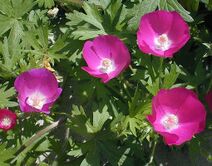Callirhoe involucrata
| Callirhoe involucrata | |
 | |
| Light: | |
| Moisture: | |
| Hardiness: | 5 |
| Soil pH: | 5.6-8.4 |
| Height: | 0.5' |
| Width: | 2' |
| Blooms: | Mid Summer-Late Summer |
| Native to: | |
| Nectary | |
| Edible Rating: | |
| Medicinal Rating: | |
| Tea: | Yes |
Callirhoe involucrata (common names: poppy mallow and purple poppy mallow)
Propagation: Seed - sow outdoors or in a cold frame. Plants resent root disturbance so the seed is best sown in situ in April[1], though the slugs will have a field day if you do not protect the plants[K]. If seed is in short supply then sow it in pots in a cold frame, putting a few seeds in each pot, and plant the pots out in early summer once the plants have put on at least 15cm of growth. Germination usually takes place within 1 - 6 months at 15°c[1].
Cuttings of young basal shoots in a frame in sand[2][3]. Harvest the shoots when they are about 10cm long with plenty of underground stem. Pot them up into individual pots and keep them in light shade in a cold frame or greenhouse until they are rooting well. Plant them out in the summer.
Division[3]. With care since the plant resents root disturbance. We have found that it is best not to disturb this plant and so do not try to divide it, relying instead on taking basal cuttings since these do not disturb the main clump[K].
Cultivation: Prefers a light rich sandy loam and a sunny position[2][3]. Likes a hot dry position[3], growing well on a dry sunny bank[4].
This species is hardy to about -15°c[3].
A deep-rooting plant[5], it strongly resents root disturbance and should be planted into its final position as soon as possible[1].
Slugs are strongly attracted to this plant and can destroy even established plants by eating out all the young shoots in spring[K].
Range: Central N. America - Minnesota and Iowa to Texas, Utah and New Mexico.
Habitat: Grows in dry soils on the plains[6][5]. Sandy, eroding dry ground and roadsides in Texas[7].
Edibility: Root - cooked[8][9][10][11]. The root is long and tapering[8], it is sweet and starchy with a pleasant taste somewhat like that of a sweet potato[12].
Leaves - cooked. A pleasant flavour with a mucilaginous texture, they are good for thickening soups[12].
Medicinal: A decoction of the root is used to treat internal pain[13][14][15]. The root was also dried, then burnt and the smoke either inhaled or allowed to bathe the affected part of the body[14][15].
Soil: Can grow in light soils.
Drainage: Prefers well drained soil.
Seed Ripens: Late Summer-Early Fall
Flower Type: Hermaphrodite
Also Known As: C. lineariloba. Malva involucrata.
Links
References
- ↑ 1.0 1.1 1.2 Bird, R. Growing from Seed Volume 3. Thompson and Morgan, 1989.
- ↑ 2.0 2.1 Chittendon, Fred. RHS Dictionary of Plants. Oxford University Press, 1951.
- ↑ 3.0 3.1 3.2 3.3 3.4 Huxley, Anthony. The New Royal Horticultural Society Dictionary of Gardening. MacMillan Press, 1992.
- ↑ Phillips, Roger and Martyn Rix. Conservatory and Indoor Plants Volumes 1 & 2. Pan Books, London, 1998.
- ↑ 5.0 5.1 Britton, Nathaniel and Addison Brown. An Illustrated Flora of the Northern United States and Canada. Dover Publications, 1970.
- ↑ Lyndon, Merritt. Gray's Manual of Botany. American Book Co, 1950.
- ↑ Diggs, George and Barney Lipscomb. Illustrated Flora of North Central Texas. Botanical Research Institute, 1999.
- ↑ 8.0 8.1 Hedrick, Ulysses. Sturtevant's Edible Plants of the World. Dover Publications, 1972.
- ↑ Tanaka, Tyōzaburō. Tanaka's Cyclopaedia of Edible Plants of the World. Keigaku Publishing, 1976.
- ↑ Yanovsky, Elias. Food Plants of the North American Indians Publication 237. US Department of Agriculture.
- ↑ Kunkel, Günther. Plants for Human Consumption. Koeltz Scientific Books, 1984.
- ↑ 12.0 12.1 Facciola, Stephen. Cornucopia - A Source Book of Edible Plants. Kampong Publications, 1990.
- ↑ Usher, George. A Dictionary of Plants Used by Man. Constable, 1974.
- ↑ 14.0 14.1 Foster, Steven and Billy Tatum. Medicinal Plants of Eastern and Central North America. Houghton Mifflin, 1990.
- ↑ 15.0 15.1 Moerman, Daniel. Native American Ethnobotany. Timber Press, 1998.